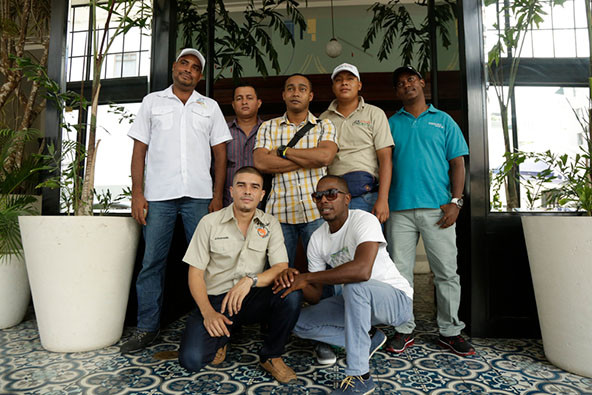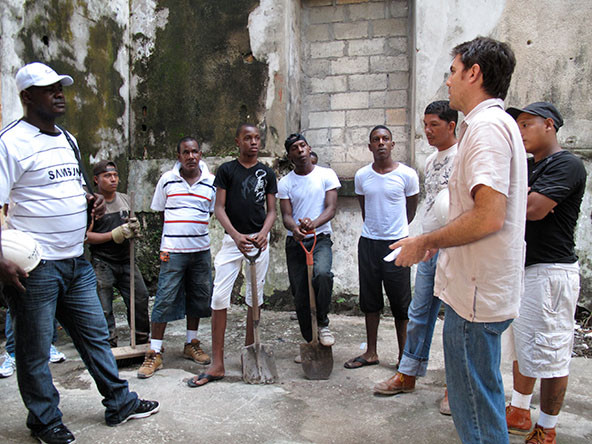_to_Scale_a_Nonprofit-592x333_-_28de80_-_17e85c9725ab86aacfe0992447cdb3fb71f14f8f.jpg) (Illustration by Luca Di Bartolomeo)
(Illustration by Luca Di Bartolomeo)
In 2020 I shut down Esperanza San Felipe, a nonprofit I had founded seven years earlier that some, including myself, once thought held the secret to tackling one of the world’s most intractable problems: gang violence. Esperanza demobilized four street gangs in one neighborhood in Panama City with positive social outcomes for many of their members. Despite its success, the organization didn’t find a path to sustainability, systematizing its process or scaling to address larger gang problems just a few blocks away, much less internationally as we once thought it might. Though we didn’t scale, we have a lot to be proud of, and the lessons we learned in the process might be instructive for social entrepreneurs and philanthropists alike.
The Beginning: Success … In One Community
I started Esperanza with the same three key ingredients as any social entrepreneur: a personal motivation to solve a tough problem where government and markets had failed, an entrepreneurial vision for how to do it, and a base from which to pursue my vision.

Emotionally, I was motivated by a tragic event—the murder of a young boy in front of my house in San Felipe, the historic district of Panama City where I have lived and worked for the past 20 years.
Importantly, I had a solid base to work from. My for-profit business, Conservatorio, had ongoing construction projects in the area. We’d had a good experience hiring ex-gang members from a local government program. And my business provided both resources and neighborhood contacts. Two such people became my partners in the project: Gilberto Toro, a sextegenerian Rastafarian who had led the government gang program, and Matt Landau, a neighbor and marketing whiz who shared my outrage at the senseless killing happening around us.
We started small. Esperanza worked with the gangs in a developing area where residents and business owners had a clear interest in supporting the program. The more I threw myself into the work, the better our results were. Beneficiaries responded well to the dignity that came with being addressed directly by a business leader. I made time to brainstorm constantly with Gilberto as we innovated around countless complex, interrelated problems for which there was no textbook. And Matt’s knack for fundraising ensured that we could always make ends meet.
The initial results were notable. Our 12-week-long interventions each began with a full-group weekend trip into the wilderness. For many gang members it was the first time they had walked in a forest, swum in a river, or even left their neighborhoods. Our methodology evolved with each intervention, but from the start it worked well enough that each of our four initial groups took the bold steps of leaving behind their collective identity as a gang, forgiving their rivals, and taking the leap to enter the formal workforce.
I enjoyed the work. I love creative problem-solving and tapping the immense power of collective action. Esperanza graduations were packed with community leaders and dignitaries who helped reinforce the message that our guys mattered. Attendees saw that most gang members are not sociopathic criminals—just young men born into tough situations. In those early days it felt that we were on to something big.
Before we attempted to scale, Esperanza had intervened with all four gangs that had previously held sway in the San Felipe neighborhood. Previously unsafe areas were rendered downright neighborly as the most notorious gang, converted itself into a successful tour company that made them local stars.
At one point, 70 percent of our graduates were either working or running their own businesses—our simple metric for success—at a cost of less than $6,000 per reintegrated gang member. Compare that to the $9,000 that Panamá spends per prisoner per year. Not a bad deal for society!
 Leaders of San Felipe’s four gangs, including Nicolas Mercado, Jafet Glissan, and Juan Acevado. (Photo courtesy of the McNulty Foundation)
Leaders of San Felipe’s four gangs, including Nicolas Mercado, Jafet Glissan, and Juan Acevado. (Photo courtesy of the McNulty Foundation)
Today, visitors to San Felipe don’t know that some of the fish they eat at local restaurants comes from Juan Acevedo, a former drug dealer, who now owns Hope Seafood, a fresh fish delivery business. They don’t realize that some of the reggaeton they hear in the clubs is produced by Nicolas “Supernick” Mercado, who once shot a rival right in front of my office. Or that the dapper lawyer driving the new Toyota is Jafet Glissant, a founding member of the former Hijos Prodigos gang.
Those anecdotes are powerful, but today the statistics tell a different story. Now, just over 30 percent of Esperanza graduates are working or have their own businesses. The rest are dead, in jail, or back hustling. Had we not tried to scale, I am certain that our success rate would have stayed much closer to our peak. That eats at me and has made me think long and hard about where we went wrong.
The Middle: Scaling and Systematizing Simultaneously
In retrospect, the trouble started when it stopped feeling like enough to be a hypothesis-driven community organization learning how to solve one big problem in one small neighborhood. I began believing that maybe Esperanza did have an answer to the wider gang problem. That hubris grew every time I was asked to present Esperanza at a forum or to meet with an NGO or multilateral; concepts like “leverage,” “scaling,” and “knowledge transfer” became part of my everyday vocabulary.
The mission creep took us 15 blocks outside our San Felipe base to the notoriously tough Santa Ana neighborhood, where we encountered a very different gang dynamic. There, things we took for granted in San Felipe, like participants walking to open-air classrooms, had to be changed to expensive transportation and secure, air-conditioned facilities. Job placement—always one of our biggest challenges—became much more difficult because of the higher levels of trauma and mental illness, which also required more experienced psychologists working under greater stress in riskier conditions. And the grants themselves required expensive staffers to administer. Scaling skyrocketed our costs and complexity while effectiveness dropped.
 KC Hardin, Esperanza’s founder, standing in the foreground at right, meets with members of Ciudad de Dios.
KC Hardin, Esperanza’s founder, standing in the foreground at right, meets with members of Ciudad de Dios.
I knew from the outset that even denting the deep Santa Ana gang culture would take years and many hundreds of thousands of dollars more than our grant covered, but the temptation was too great. The leaders of the Santa Ana gangs had reached out to us to plead for their turn at intervention—which felt amazing and thrilled the team. As founder, I felt pressure to keep Esperanza’s team fed and the success story continuing.
That we needed a new playbook is ironic because we had recently accepted a separate grant to systematize our know-how and share Esperanza’s methodology internationally. We couldn’t even export our emergent field-work learnings to the next neighborhood, much less the world!
Another buzzword that proved elusive for us was “sustainability.” When we started, sustainability just meant being good at email campaigns and events, which was my colleague Matt’s forte. But when Matt moved on and we began to move into the professional donor world, we discovered a funding community with a deep aversion to “creating dependencies.” That led us to explore more exotic financing strategies, like impact bonds, overhead sharing with other foundations, and launching an apparel line complete with $25 lapel pins.
None of those initiatives bore much fruit, and increasingly, I personally funded Esperanza’s budget shortfalls while taking on the role of chief fundraiser that Matt had previously held. The financial and time commitments required were difficult to sustain—and that was before COVID-19 struck.
The End: The Pandemic Revealed Our Precarity
The coronavirus hit Panama particularly hard. The government instituted a rent moratorium and stopped most commerce and construction for seven months. My company’s revenues dropped 90 percent practically overnight, but expenses and debt, of course, did not. Suddenly, Conservatorio, the very base that allowed me to start Esperanza in the first place, needed all of my capital and my full attention to survive.
After a few frantic weeks of sending food to our most needy beneficiaries, I realized the pandemic’s severity and made the decision to shutter Esperanza and focus on saving Conservatorio. Esperanza’s grants had run out by then, and Panama was on full lockdown, making our classroom-based methodology impossible. The decision to close was made somewhat easier because the lockdown reduced gang violence to nearly zero and a national food coupon program ensured our participants’ basic needs were being met.
Today, I keep in touch with many Esperanza graduates. I take pleasure in being able to help them with small things and worry that I no longer have the infrastructure to deal with bigger issues. But I have come to accept that Esperanza was just a program that had a life cycle and hopefully left a nice legacy of relationships, changed perceptions, and saved lives.
The Moral of the Story
The new ideal of the “social unicorn”—that “systematizes” its model, “scales” globally, and achieves “sustainability”—is powerful because it reconciles our free-market, entrepreneur-centric values with our desire to see a better world. But while those buzzwords carry useful concepts that should be in every social entrepreneur’s vocabulary, they should not be taken as imperatives. To social entrepreneurs in the early stages of building a nonprofit organization, I would offer the following advice:
There’s no shame in focusing on quality over quantity. For some leaders, this might require an ego check and for others, it might just mean being more creative about defining success. For funders, it means getting over the fear of forming dependencies and taking pride in long-term commitments to effective organizations of any size.
Dependence on donations is not a sin. Esperanza wasted scarce resources and time trying to become a sustainable social enterprise, which in retrospect should have been invested in building a broader, more reliable, and more aligned donor base. For many nonprofits, sustainability simply means getting really good at asking for donations.
Believing you can do anything is powerful; believing you can do everything is foolish. I tried to simultaneously scale the geographies and missions of Esperanza and Conservatorio, two innovative, complex organizations. Entrepreneurs of all kinds are optimistic by nature, and in both my business and impact circles, I was encouraged to think big. I would have done well to also think pragmatically.
You don’t have to leave the business world to benefit society. I don’t regret launching Esperanza, but I also wouldn’t hesitate to recommend someone in a similar position to double down on their core business. The backbone of a better future may lie in more for-profit companies doing ordinary things in highly responsible ways.
Support SSIR’s coverage of cross-sector solutions to global challenges.
Help us further the reach of innovative ideas. Donate today.
Read more stories by KC Hardin.

